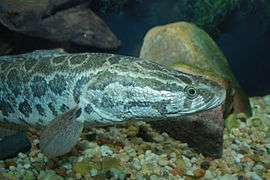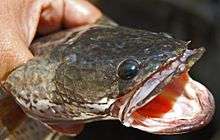Snakehead (fish)
The snakeheads are members of the freshwater perciform fish family Channidae, native to parts of Africa and Asia. These elongated, predatory fish are distinguished by their long dorsal fins, large mouths, and shiny teeth. They breathe air with gills, which allows them to migrate short distances over land. They have suprabranchial organs, which are primitive forms of labyrinth organs, that develop when they grow older.[1] The three extant genera are Channa and Aenigmachanna in Asia and Parachanna in Africa, consisting of more than 50 species.
| Snakehead | |
|---|---|
 | |
| Northern snakehead, Channa argus | |
| Scientific classification | |
| Kingdom: | Animalia |
| Phylum: | Chordata |
| Class: | Actinopterygii |
| Order: | Anabantiformes |
| Suborder: | Channoidei Berg, 1940 |
| Family: | Channidae Fowler, 1934 |
| General | |
|
see text | |
They are valuable as a food source and have become notorious as an intentionally released invasive species.
Description
The various species of snakeheads differ greatly in size; dwarf snakeheads, such as Channa orientalis, do not surpass 25 cm (10 in) in length. Most other snakeheads reach between 30 and 90 cm (12 and 35 in). Five species (C. argus, C. barca, C. marulius, C. micropeltes, and C. striata) can reach 1 m (3 ft 3 in) or more.[2]
Snakeheads are thrust-feeders that consume plankton, aquatic insects, and mollusks when small. As adults, they mostly feed on other fish (such as carp) or on frogs. In rare cases, small rodents such as rats are eaten.
History
The Channidae are well represented in the fossil record and known from numerous specimens. They likely originated in the south Himalayan region of the Indian subcontinent (modern-day northern India and eastern Pakistan) at least 50 million years ago (Mya), during the Early Eocene epoch. Two of the earliest known species, Eochanna chorlakkiensis and Anchichanna kuldanensis , have both been found in the Middle Eocene of Pakistan.[3][4] By 17 Mya, during the Early Miocene, Channidae had spread into western and central Eurasia, and by 8 Mya, during the late Tortonian, they existed throughout Africa and East Asia.[5] As Channidae are adapted to climates of high precipitation with mean temperatures of 20°C (68°F), their migrations into Europe and Asia correspond to the development of the Intertropical Convergence Zone, which increased air humidity, and the intensification of the East Asian monsoon. Both weather patterns emerged due to greater vertical growth of the Alps, Pyrenees, and Himalayas, which affected Eurasian climatic patterns.[5]
Ecological concerns

Snakeheads can become invasive species and cause ecological damage because in many areas to which they are not native, the absence of natural enemies gives them apex predator status. Not only can they breathe air, but they can also survive on land up to four days, provided they are wet, and are known to migrate up to 400 m (1/4 mi) on wet land to other bodies of water by wriggling with their bodies and fins. National Geographic has referred to snakeheads as "fishzilla"[6] and the National Geographic Channel reported the "northern snakehead reaches sexual maturity by age two or three. Each spawning-age female can release up to 15,000 eggs at once. Snakeheads can mate as often as five times a year. This means in just two years, a single female can release up to 150,000 eggs."[7]
"Since 2002, it has been illegal to possess a live snakehead in many US states, where they are considered a destructive invasive species."[8] Virginia has criminalized the "introduc[tion]" of snakeheads into the state without specific authorization, although the relevant statute does not explain whether mere importation is sufficient to constitute "introduc[tion] into the Commonwealth" or whether instead release into the environment is required.[9]
Intentional introductions
Humans have been introducing snakeheads to nonindigenous waters for over 100 years. In parts of Asia and Africa, the snakehead is considered a valuable food fish, and is produced in aquacultures (fisheries motivation) or by accidental release (as was the case in Crofton, Maryland). Examples of the introduction of snakeheads to nonindigenous waters include:
- Channa maculata was introduced to Madagascar and to Hawaii around the end of the 19th century. It can still be found there today.
- Channa striata was introduced to islands east of the Wallace line by governmental programs in the latter half of the 20th century. In Fiji, the introduction failed.
- Channa asiatica, which is native to southern China, was introduced to Taiwan and to southern Japan; the origin of and reason for the introduction are unknown.
- Channa argus, which is native to northern China's Amur River, was introduced to central Asia (Kazakhstan, Turkmenistan, and Uzbekistan). It was introduced from the Korean Peninsula to Japan about 100 years ago due to fisheries' motivations. Its introduction to Czechoslovakia by its government in the 1960s failed.
Reported sightings
In the United States
Snakeheads became a national news topic in the United States because of the appearance of C. argus, commonly known as northern snakeheads, spawning in a Crofton, Maryland, pond in 2002.[8] Northern snakeheads became permanently established in the Potomac River around 2004;[10] and possibly established in Florida.[8] In about 120 mi (190 km) of river, the population has surpassed 21,000 individuals.[11]
According to the United States Environmental Protection Agency, snakeheads have also been spotted in California, Delaware, Florida, Georgia, Hawaii, Maine, Maryland, Massachusetts, Virginia, and Rhode Island.[12]
World record
According to the International Game Fish Association, Caleb Newton, a Spotsylvania County, Virginia, resident, caught a world-record 17 lb 6 oz (7.9 kg) northern snakehead at the junction of Aquia Creek and the Potomac River, United States, on June 1, 2013. The previous record, 2 oz (57 g) smaller, had been caught in 2004, in Miki, Kagawa, Japan.[13]

As food
Snakeheads are valuable food fish. Called nga yant in Burmese, in Manipuri as ngamu, they are prized fish eaten in a variety of ways. In Vietnam, they are called cá lóc, cá quả, or cá chuối, and are prized in clay-pot, steamed and pickled preparations. Larger species, such as C. striata, C. maculata, and Parachanna obscura, are farmed in aquaculture. In the United States, chefs have suggested controlling the snakehead invasion by serving them in restaurants.[14] In Indonesia, snakehead fish are called ikan gabus, served as the main parts of traditional dishes such as Betawis' pucung gabus, and considered to be a delicacy due to their rarity in the wild and in aquaculture, as they are harder to raise than other popular freshwater fish such as catfish and carp.
_5.jpg)
Classification
The snakeheads comprise three extant genera:
- Aenigmachanna Britz, Anoop, Dahanukar & Raghavan 2019 (two species native to India)
- Channa Scopoli, 1777 (49 species native to Asia)
- Parachanna Teugels & Daget 1984 (three extant species, one fossil species, all native to Africa)
Two other genera are only known from fossils:
In popular culture
After its release in non-native North American waters, either accidentally or intentionally, the aggressive and predator-free snakehead's reputation as a "Frankenfish"[16] or "monster fish" has become part of the culture[17] Besides mentions on TV shows such as The Sopranos[18] and The Office[19] and CSI:NY episode "Sangre por Sangre", the snakehead has been featured in three Sci-fi Channel original pictures entitled Snakehead Terror, Frankenfish, and Swarm of the Snakehead. In the Animal Planet TV series River Monsters, Jeremy Wade shows a dramatization of a snakehead, "the fish from hell", stalking an unsuspecting baby and Chihuahua. With the help of a snakehead researcher, however, Wade shows that although it is capable of living outside of water and is able to move on land, its weak pectoral muscles make movement difficult and render the snakehead an unlikely "stalker" on land.[20]
See also
References
- Pinter, H. (1986). Labyrinth Fish. Barron's Educational Series, Inc., ISBN 0-8120-5635-3.
- Froese, Rainer and Pauly, Daniel, eds. (2014). Species of Channa in FishBase. June 2014 version.
- Murray, A. M.; Thewissen, J. G. M. (2008). "Eocene actinopterygian fishes from Pakistan, with the description of a new genus and species of channid (channiformes)". Journal of Vertebrate Paleontology. 28: 41–52. doi:10.1671/0272-4634(2008)28[41:EAFFPW]2.0.CO;2.
- Roe, L. J. (1991). "Phylogenetic and Ecological Significance of Channidae (Osteichthyes Teleostei) from the Early Eocene Kuldana Formation of Kohat, Pakistan". Contributions from the Museum of Paleontology. 28 (5): 93–100. hdl:2027.42/48541.
- Böhme, M. (2004). "Migration history of air-breathing fishes reveals Neogene atmospheric circulation patterns". Geology. 32 (5): 393. doi:10.1130/G20316.1.
- Cruz, Elena (2007-12-03). "Snakehead Frenzy!". NGC Blog. National Geographic Channel.
- "Fishzilla: Snakehead Invasion". Wild. National Geographic Channel. Archived from the original on 2008-05-15. Video clip titled: "The Northern Snakehead fish wreaks havoc".
- Courtenay, Jr., Walter R. and James D. Williams. USGS Circular 1251: Snakeheads (Pisces, Chinnidae) - A Biological Synopsis and Risk Assessment. U.S. Department of the Interior, U.S. Geological Survey. 2004-04-01. Retrieved 2012-04-16.
- Code of Virginia § 18.2-313.2: "Any person who knowingly introduces into the Commonwealth any snakehead fish of the family Channidae[...] without a permit from the Director of Game and Inland Fisheries [...] is guilty of a class 1 misdemeanor [punishable by up to twelve months in jail and/or a fine of up to $2,500]."
- Potomac snakeheads not related to others Associated Press, Baltimore Sun, 27 April 2007.
- 2016, Brian Clark Howard PUBLISHED Thu Mar 17 07:00:00 EDT (2016-03-17). "Fishermen Battle Invasive 'Frankenfish' Snakeheads". National Geographic News. Retrieved 2016-03-18.CS1 maint: numeric names: authors list (link)
- "History of introduction in the United States: Four species of snakeheads (Channa argus, C. marulius, C. micropeltes, and C. striata) have been recorded from open waters of the United States (California, Florida, Hawaii, Maine, Maryland, Massachusetts, and Rhode Island), and two have become established as reproducing populations." Injurious Wildlife Species; Snakeheads Environmental Protection Agency. Retrieved 17 February 2008.
- Rusty Dennen (6 August 2013). "Spotsylvania resident Caleb Newton snags world-record snakehead". news.fredricksburg.com. Archived from the original on 2013-08-09.
- "Chefs' solution for invading 'Frankenfish'? Eat 'em". News.msn.com. Archived from the original on 2014-03-20. Retrieved 2014-03-20.
- A. M. Murray & J.G.M. Thewissen. "Eocene actinopterygian fishes from Pakistan, with the description of a new genus and species of channid (channiformes)". Journal of Vertebrate Paleontology. 28 (1): 41–52. doi:10.1671/0272-4634(2008)28[41:EAFFPW]2.0.CO;2.
- "B.C.'s snakehead caught after Burnaby pond drained. CBC News (Posted: June 8, 2012)". Cbc.ca. 2012-06-08. Retrieved 2014-03-20.
- "The Ultimate Monster Fish: The Frankenfish Snakehead", Carina Suarez, 28 July 2014, National Geographic
- "Soprano Home Movies" episode 13, season 6, The Sopranos, 8 April 2007, HBO
- The Office US (2018-02-24), Blackmail - The Office US, retrieved 2018-04-01
- "GIANT SNAKEHEAD". animal.discovery.com. Archived from the original on 2012-08-20.
Further reading
- Froese, Rainer, and Daniel Pauly, eds. (2006). "Channidae" in FishBase. January 2006 version.
- "Channidae". Integrated Taxonomic Information System. Retrieved 20 March 2006.
External links
| Wikimedia Commons has media related to Channa striata. |
| Wikispecies has information related to Channidae |
- Snakeheads—A Biological Synopsis and Risk Assessment published by the U.S. Geological Survey
- About.com's article on Snakeheads
- snakeheads.org world's largest website for snakeheads
- Overview of Northern Snakehead biology
- Fish or Foul: Snakeheads near Washington, D.C., and the people who love them